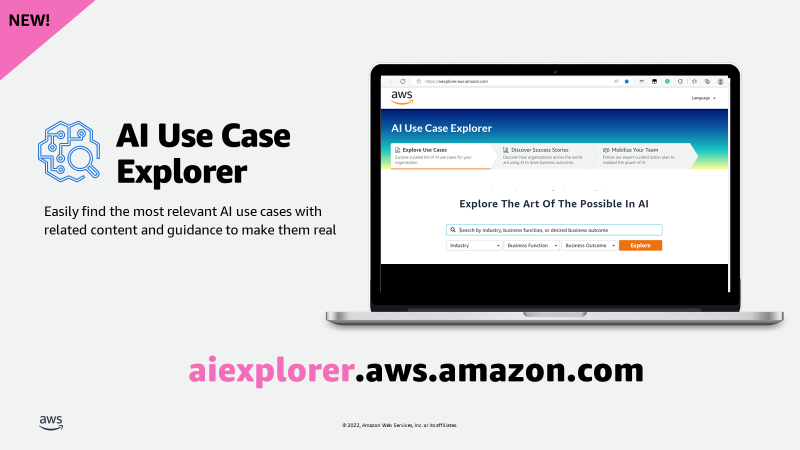AWS Public Sector Blog
3 ways tax agencies can use AI on AWS

State and local tax agencies process millions of tax filings and collect billions of tax dollars annually to support essential public services in health, safety, and education, as well as critical infrastructure such as roads and utilities. Despite the central role of tax agencies in supporting state economies and local communities, many are challenged with legacy systems that lack flexibility and functionality.
To gain operational efficiencies and reduce workload burdens on employees, some state finance and tax agencies are leveraging robotic process automation (RPA) on Amazon Web Services (AWS). RPA is a software tool that integrates with almost any system or application and performs manual, repetitive, time-consuming tasks. The value of RPA, when combined with artificial intelligence (AI) and machine learning (ML), now goes well beyond automated data entry and processing of tax bills. AI is any method by which a computer replicates tasks usually performed by humans. ML, a subset of AI, refers to a computer using algorithms and ingesting large quantities of structured and unstructured data to detect data patterns and relationships to draw conclusions. This robust technology has been coined as intelligent automation or hyper-automation, and it can work alongside humans to perform work or operate in the background without human supervision.
Tax agencies can use AI and ML to support the sheer size and scale of data they manage and to access and analyze all types of data with ease, including voice, video, and streaming data. AI and ML can help answer questions on classification (Is this X or Y?), anomaly detection (Is this unusual?), regression analysis (By how much/By how many?), clustering (How is it organized?), and reinforcement learning (What is the next step?).
AI and ML are creating measurable outcomes for tax agencies in three important ways:
1. Transforming the citizen experience
Tax agencies are streamlining the citizen experience with chatbots, virtual assistants, intelligent contact centers, and personalization. Omnichannel communications empower tax agencies to respond to taxpayer demand for digital engagement and offer more effective citizen services on a 24/7 basis. Tax agencies receive thousands of inquiries where AI chatbots can timely answer common questions or facilitate completion of transactions without human intervention. Chatbots can even respond in multiple languages or translate speech to text using services like Amazon Transcribe. Embedded analytics and sentiment analysis in intelligent contact centers can also improve first-call resolution and agent productivity. Some finance and tax agencies are also using Amazon Connect, an omnichannel, cloud-based contact center service, to give citizens more convenient options to complete transactions.
2. Protecting tax dollars from fraud, waste, and abuse
Cloud technology can support speed and confidence in government decision-making with intelligent search capabilities, improving forecasting with predictive analytics, or detecting anomalies in data. Tax agencies can access relevant and historical information faster, increase accuracy of tax revenue forecasting, and use predictive modeling to detect tax fraud or non-compliance. Predictive modeling helps auditors by assessing data for attributes that signal risk, and AI digs through mountains of data to find subtle clues that can get overlooked by audit teams. Predictive modeling can also be used to analyze corporate and seasonal data to uncover trends in tax filing cycles on a monthly, quarterly, or annual basis. For tax agencies tasked with distributing grant funds from COVID-19 relief programs, AI can review written reports to determine if grant funds spent meet required criteria and generate a risk score if not. Amazon Fraud Detector uses AI and ML models based on Amazon’s more than 20 years of experience in detecting patterns associated with fraudulent activity and can be embedded in any application operating in the cloud.
3. Improving government operations
Intelligent document processing and quality control can also optimize government operations. Tax agencies can optimize time and resources because AI can process large volumes of information in less time and perform any kind of statistical calculation. Intelligent document processing tools like Amazon Textract and Amazon Comprehend can extract and redact data, and metadata, from tax filings, notices, and payments received electronically, and handle tax classification and calculations. This helps reduce manual reviews of thousands of transactions annually to just a few hundred. It also enables search and discovery. A commissioned Forrester Total Economic Impact™ study indicates organizations can improve productivity and reduce costs by 50 percent by implementing AI into their document pipelines. Intelligent automation can also be used to increase accuracy and simplify the comparison process for transfer pricing rather than tax teams spending hours to search company databases for comparable pricing structures.
Getting started in AI and ML for government agencies
As tax agencies embark on their intelligent automation journey, they may want to consider taking a small step first. Pick a problem you want to solve, build a hypothesis, and then test it using historical data. The next steps will require an investment of time to teach the computer the language of tax, including tax laws and IRS requirements. AI and ML are designed to spot patterns and avoid past errors, so devoting time up front to train the computer with questions, provide the right answers, and correct it when it gives wrong answers is crucial.
Protecting sensitive data is also paramount. Set up a responsible framework that defines, monitors, and manages who has access to data and how it is used. Develop AI implementation guidelines that include transparency of algorithms used. Invest in training. Taking these steps will help make sure the rights of taxpayers are preserved in a digital environment. You can learn more with resources like the National Artificial Intelligence Initiative and the U.S. General Services Administration’s online Center of Excellence.
AWS can help support the journey with in-person and online trainings, acceleration programs, or professional services support. Tax agencies can explore our newest tool – AI Use Case Explorer – to find hundreds of use cases and success stories as well as videos, demos, e-books, and action plans.
Learn more about how state and local government agencies use AWS to support their constituents and staff at the Cloud for State and Local Governments hub.
Read related stories on the AWS Public Sector Blog:
- Taxes, governments, and great experiences using the cloud
- How the US DOJ Tax Division built a remote telework application in six weeks with AWS
- How nonprofits can automate tax-exempt status across AWS accounts
- How human-centered design can help public agencies design better digital services
- How public sector agencies can identify improper payments with machine learning
Subscribe to the AWS Public Sector Blog newsletter to get the latest in AWS tools, solutions, and innovations from the public sector delivered to your inbox, or contact us.
Please take a few minutes to share insights regarding your experience with the AWS Public Sector Blog in this survey, and we’ll use feedback from the survey to create more content aligned with the preferences of our readers.
